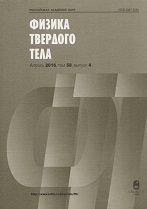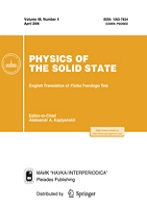|
This article is cited in 2 scientific papers (total in 2 papers)
Polymers
Polymer piezoelements based on porous polyvinylidene fluoride films and contact electrode polyaniline layers
G. K. Elyashevich, I. S. Kuryndin, E. Yu. Rosova, N. N. Saprykina
Institute of Macromolecular Compounds, Russian Academy of Sciences, St. Petersburg
Abstract:
The preparation method to obtain the new hybrid piezoelectric systems is developed. In it, layer-by-layer oxidative polymerization of aniline is performed in situ on porous polyvinylidene fluoride films prepared by melt extrusion. The formation of conducting form of polyaniline (i.e., emeraldine salt) is confirmed by IR spectroscopy. The samples with double polyaniline layers exhibit a higher electrical conductivity than single-layer ones, with the electrical conductivity growing as the degree of substrate’s orientation increases. The observed effect is related to improved uniformity and structural ordering of the conducting layer, as shown by scanning electron microscopy. The obtained hybrid systems exhibit a higher mechanical strength, elastic modulus, and break elongation, compared to the substrate. The electric and piezoactive properties of prepared samples are studied by cyclic voltammetry and by measuring their piezoelectric modulus; the deposited polyaniline layers served as the contact electrode material in these measurements. The values for piezoelectric coefficients were measured in variuos directions of applied mechanical load.
Keywords:
polyvinylidene fluoride, polyaniline, porous films, electroconductivity, piezomodulus.
Received: 05.11.2019
Revised: 05.11.2019
Accepted: 05.11.2019
Citation:
G. K. Elyashevich, I. S. Kuryndin, E. Yu. Rosova, N. N. Saprykina, “Polymer piezoelements based on porous polyvinylidene fluoride films and contact electrode polyaniline layers”, Fizika Tverdogo Tela, 62:3 (2020), 494–501; Phys. Solid State, 62:3 (2020), 566–573
Linking options:
https://www.mathnet.ru/eng/ftt8482 https://www.mathnet.ru/eng/ftt/v62/i3/p494
|


| Statistics & downloads: |
| Abstract page: | 99 | | Full-text PDF : | 75 |
|





 Contact us:
Contact us: Terms of Use
Terms of Use
 Registration to the website
Registration to the website Logotypes
Logotypes









 Citation in format
Citation in format 